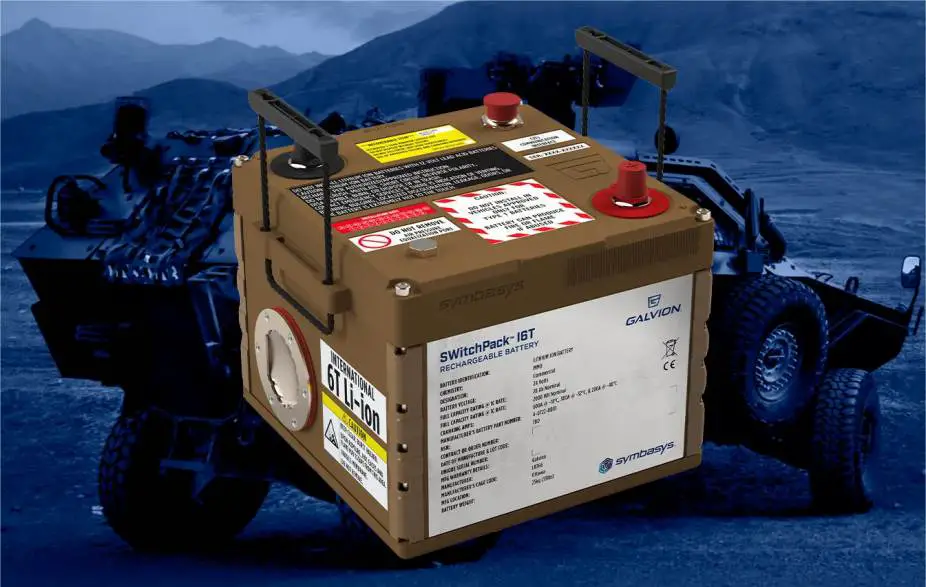Batteries, in one form or another, have existed for over 200 years. They have been used to power everything from modern phones to electric vehicle propulsion systems, and are the key enabler for future renewable energy sources. The demand for energy storage cells will only continue to grow with our increasing demand for electrical systems, particularly in the case of large-scale military platform applications.
Follow Army Recognition on Google News at this link

Galvion’s Symbasys SWitchPack™ i6T Li-ion vehicle battery meets demanding military standards including MIL-STD-1275, MIL-STD-810 and MIL-PRF-32565B. Furthermore, the i6T has been demonstrated safe when subjected to extensive ballistic and non-ballistic penetration and meets stringent UN 38.3 commercial safety standards. (Picture source: Galvion )
The lead-acid battery, invented by Gaston Planté in 1859, is commonly found in vehicles of today due to the economies of production. As the name suggests, lead-acid batteries require acid: normally sulfuric acid (H₂SO₄) to produce a voltage, blended with distilled water and immersing lead plates. There are drawbacks with these batteries, especially in a military environment. Most military vehicles, when not on operations, spend long periods of time parked and unused, often in hot environments, which is not an ideal usage cycle for lead-acid batteries. Battery shops within units are set up to store, service and maintain batteries, taking up valuable man-hours. When inactive, the batteries suffer from de-sulphation/stratification if incorrectly managed and can require 7 to 10 days to trickle charge in order to recover the battery. Often, the battery is unrecoverable and must be replaced, adding significant costs for the fleet manager.
Many military vehicles are built around a hull, a similar principle to a boat. Lead-acid batteries need ventilation to expel by-product gases i.e. hydrogen sulfide. They in turn lose acid levels and need to be topped up on a regular basis, particularly in hot conditions, as the batteries can ‘cook off’ their levels. This means that, on lengthy operations, battery fluid must be carried onboard which, while very necessary, adds risk to personnel.
Even under ideal conditions, with regular maintenance, fluid top-ups and usage, lead-acid batteries can have as little as 50 recharge cycles, and are often replaced every 3 months, ‘just to be safe’, meaning additional supplies, disposal, logistics, etc.
In comparison, the benefits of lithium-type batteries are massive. They are maintenance-free across a multi-year service lifespan with significantly less weight than a traditional lead-acid battery. Able to provide power for long periods, lithium-ion batteries are ideal in a silent watch scenario when the engine cannot be running for tactical reasons. In some cases, a one-hour charge can provide a full day of power, delivering the perfect power source for reconnaissance missions with minimal risk of being compromised and drastically reduced fuel consumption.
Galvion has developed a military-optimized Li-ion battery, the SymbasysSwitchPack i6T Li-ion vehicle battery. From a user perspective, Galvion’s i6T battery offers considerable capability enhancements and through-life efficiencies. Admittedly, the up-front cost cannot be compared to that of the traditional lead-acid alternative, however, it is the cost over life that ultimately makes Li-ion the choice for the future. Maintenance-free across a 10-year service lifespan, delivering as much as 8,000 recharge cycles; over twice that offered by any alternative 6T Li-ion unit. Compared to a traditional lead-acid 6T battery, Galvion’s SwitchPack delivers 3 times the useable capacity and energy at 24Volts (78Ah) and is 38% lighter in weight. Because of the reliability, through-life cost savings are 87% compared to lead-acid 6T alternatives and 43% compared to other 6T Li-ion brands.
Galvion’s i6T Li-ion vehicle battery meets demanding military standards including MIL-STD-1275, MIL-STD-810 and the performance of MIL-PRF-32565, as well as stringent UN 38.3 commercial safety standards.
Some have questioned the auto shut down functionality of most lithium batteries given that most lithium batteries have a Battery Management System (BMS). To address this concern, Galvion has developed a battlefield override to squeeze every ounce of energy on a critical mission if required, in all battlefield temperature scenarios. The inclusion of a BMS allows the crew to better monitor power usage and remaining capacity, avoiding the surprises often associated with lead-acid batteries that have been allowed to run down a little too far to restart the vehicle’s engine.
Despite the clear advantages offered when selecting Li-ion over Lead Acid, there are some integration challenges to ensure the new battery technology can be installed safely in a demanding military environment. Recent programs with International partners included the design, manufacture and delivery of ballistic enclosures to house the Li-ion batteries. The custom-built enclosure, like the one below containing three (3) i6T batteries for 234Ah, is then mounted on or in vehicles with minimal vehicle modifications required. Galvion leads the way in the development of integration solutions to enable the full functionality while remaining safe and compliant, across a wide range of in-service and future military platforms.















